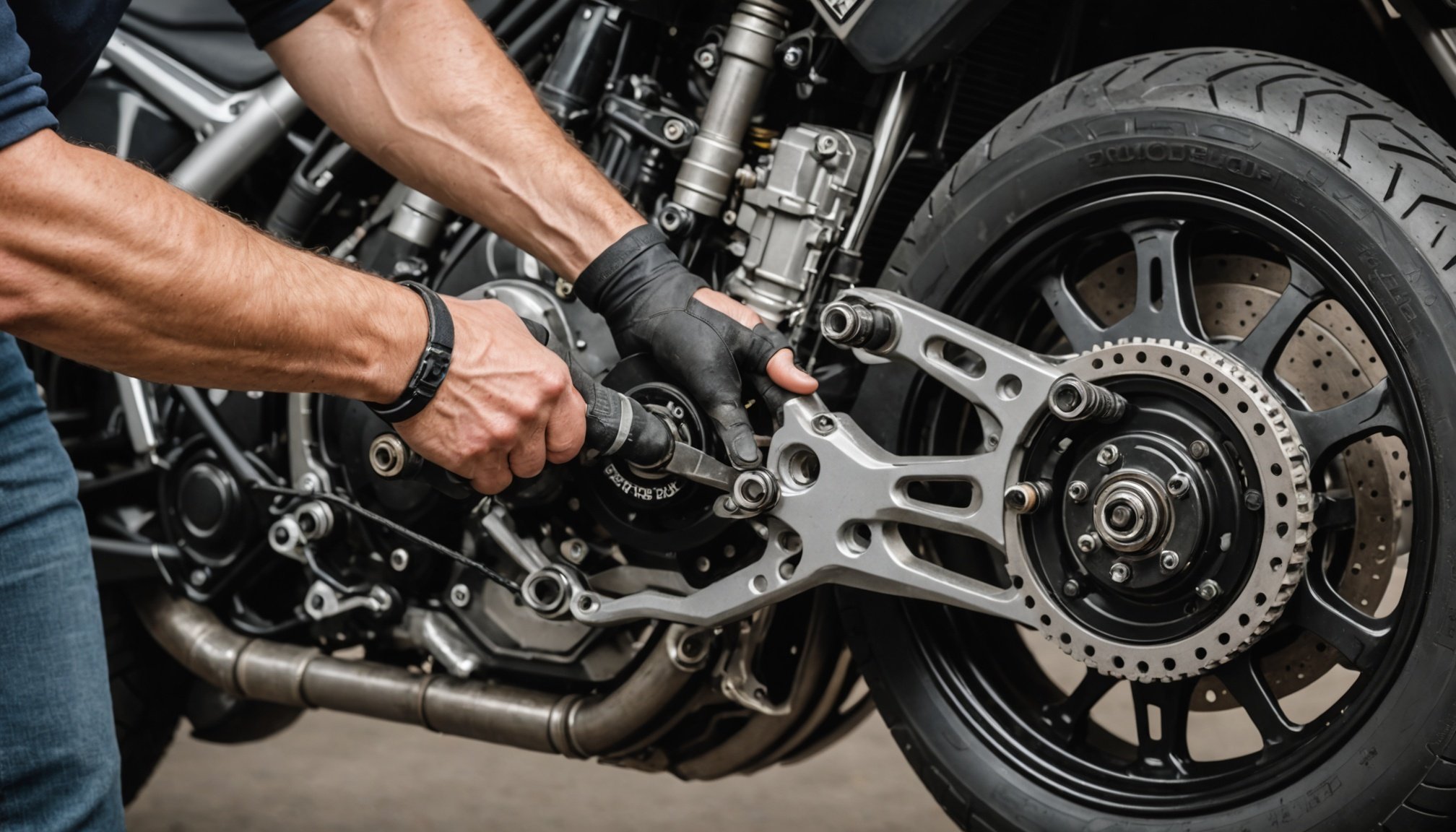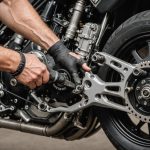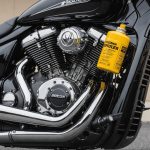A Step-by-Step Guide to Changing the Rear Brake Pads on Your Triumph Tiger 900
Preparing for the Job: Tools and Safety
Before you dive into changing the rear brake pads on your Triumph Tiger 900, it’s crucial to ensure you have all the necessary tools and take the appropriate safety precautions. Here’s a list of what you’ll need:
-
Tools:
Also read : Step-by-Step Guide: How to Properly Install a Top Box on Your Honda Goldwing
-
A set of Allen wrenches
-
A Torx screwdriver (for some models)
Additional reading : Step-by-Step Guide: Mastering Oil and Oil Filter Changes on Your Honda Fury
-
A C-clamp or brake pad spreader
-
New rear brake pads (specific to the Triumph Tiger 900)
-
Brake fluid (if you plan to bleed the brakes)
-
Clean rags
-
Safety gloves and goggles
-
Safety Precautions:
-
Ensure the motorcycle is on a level surface and securely supported by a center stand or paddock stand.
-
Wear protective gear such as gloves and goggles to avoid injury from sharp edges or brake fluid.
-
Make sure the motorcycle is cool to avoid any burns or injuries.
Understanding Your Triumph Tiger 900’s Brakes
The Triumph Tiger 900, particularly the Rally Pro model, is equipped with advanced braking systems designed for both on-road and off-road performance. Here’s a brief overview of what you’re working with:
-
Rear Brakes:
-
The Triumph Tiger 900 Rally Pro features a single 255mm disc brake with a single piston sliding caliper. This setup is optimized with cornering ABS for enhanced safety and control[4].
-
Importance of Regular Maintenance:
-
Regularly checking and replacing the brake pads is essential for maintaining optimal braking performance and ensuring your safety on the road.
-
Worn-out brake pads can lead to reduced braking efficiency, increased stopping distances, and potentially dangerous situations.
Step-by-Step Instructions
Removing the Old Brake Pads
- Lift the Motorcycle:
- Use a center stand or paddock stand to lift the rear wheel off the ground. Ensure the motorcycle is stable and secure.
- Remove the Caliper:
- Use an Allen wrench to loosen the caliper bolts. Once loose, slide the caliper off the rotor. Be careful not to damage the brake hose.
- Use a piece of wire or a rubber band to suspend the caliper from the frame, keeping it away from the rotor.
- Take Out the Old Pads:
- Pull out the old brake pads from the caliper. Note the position and orientation of the pads for when you install the new ones.
Installing the New Brake Pads
- Prepare the New Pads:
- Before installing the new pads, ensure they are the correct type for your Triumph Tiger 900. Consult your manual or contact a Triumph dealer if you’re unsure.
- Remove any protective film from the back of the pads.
- Install the New Pads:
- Insert the new brake pads into the caliper, ensuring they are properly seated and aligned.
- Make sure the retaining clips or springs are securely in place.
- Reinstall the Caliper:
- Slide the caliper back over the rotor, ensuring it is properly aligned.
- Tighten the caliper bolts in a star pattern to avoid warping the rotor.
Bleeding the Brakes (If Necessary)
If you’ve disturbed the brake system or notice any air in the lines, you may need to bleed the brakes:
-
Gather Materials:
-
Brake fluid
-
A brake bleeding kit
-
Clean rags
-
Bleeding Process:
-
Attach the bleeding kit to the brake caliper and pump the brake lever several times to push out any air bubbles.
-
Check the brake fluid level and top it off if necessary.
Post-Installation Checks
After installing the new brake pads, it’s crucial to perform several checks to ensure everything is working correctly:
Brake Pad Clearance
- Use a C-clamp or brake pad spreader to ensure the brake pads are not touching the rotor when the brake lever is released.
- Adjust the caliper if necessary to achieve the correct clearance.
Brake Fluid Level
- Check the brake fluid level in the reservoir and top it off if it’s low.
- Ensure there are no leaks in the brake system.
Test the Brakes
- Take your motorcycle for a test ride to ensure the brakes are functioning properly.
- Apply the brakes several times at different speeds to bed in the new pads.
Additional Tips and Considerations
Tyre Pressure and Traction Control
-
Tyre Pressure:
-
Proper tyre pressure is crucial for optimal braking performance. Make sure to check and adjust the tyre pressure according to the manufacturer’s recommendations.
-
Incorrect tyre pressure can affect traction and braking efficiency.
-
Traction Control:
-
The Triumph Tiger 900 Rally Pro comes with advanced traction control systems. Ensure these systems are set correctly for your riding conditions.
-
Adjusting the traction control settings can help optimize your motorcycle’s performance on different terrains.
Rider Seat and Riding Position
-
Rider Seat:
-
The riding position and seat height can affect how you interact with the brakes. Ensure the seat height is adjusted to your comfort and riding style.
-
A well-adjusted seat height can improve control and confidence while braking.
-
Riding Position:
-
Maintain a balanced riding position to ensure optimal control over the motorcycle.
-
Practice different braking techniques in a safe environment to build your skills.
Changing the rear brake pads on your Triumph Tiger 900 is a manageable task that can significantly enhance your motorcycle’s performance and safety. Here’s a summary of the key points:
| Step | Description |
|---|---|
| Prepare Tools and Safety | Gather necessary tools, ensure safety precautions |
| Understand Brakes | Familiarize yourself with the Triumph Tiger 900’s braking system |
| Remove Old Pads | Lift motorcycle, remove caliper, take out old pads |
| Install New Pads | Prepare new pads, install them, reinstall caliper |
| Bleed Brakes (If Necessary) | Use bleeding kit to remove air bubbles |
| Post-Installation Checks | Check brake pad clearance, brake fluid level, test brakes |
| Additional Tips | Check tyre pressure, adjust traction control, adjust rider seat and position |
Quotes and Insights
- “Regularly checking and replacing the brake pads is essential for maintaining optimal braking performance and ensuring your safety on the road.” – Motorcycle Maintenance Guide
- “The Triumph Tiger 900 Rally Pro features a single 255mm disc brake with a single piston sliding caliper. This setup is optimized with cornering ABS for enhanced safety and control.” – Total Motorcycle[4]
- “Proper tyre pressure is crucial for optimal braking performance. Make sure to check and adjust the tyre pressure according to the manufacturer’s recommendations.” – Tyre Pressure Guide
By following these steps and tips, you’ll be able to change your rear brake pads confidently and ensure your Triumph Tiger 900 remains in top condition for your next ride. Remember, safety and maintenance are key to a enjoyable and safe riding experience.
Reassembling and Testing
After installing the new brake pads, the next crucial step is to reassemble and test your Triumph Tiger 900 to ensure everything is fitted properly and functioning optimally.
Reattaching and Securing Components
Begin by securely reattaching the wheel and any other components that were removed. Ensure all bolts and fittings are tightened to the manufacturer’s specifications using a torque wrench. This will prevent any part from becoming loose while riding, maintaining stability and functionality.
Testing Brake Functionality
Once reassembled, it’s vital to test the brakes comprehensively. Start by cautiously pressing the brake lever a few times to build pressure within the system. This primes the brake pads, ensuring they engage promptly. Then, perform a stationary test by gently moving the bike forward and applying the brakes to confirm they respond correctly.
Importance of a Test Ride
Finally, conduct a test ride in a safe, open area. Begin with slow speeds, gradually increasing as you confirm the brakes’ effectiveness. Pay attention to any unusual noises or sensations that might indicate issues. This practical test ensures that the recent maintenance enhances the motorcycle’s performance, guaranteeing a safe and smooth riding experience.











